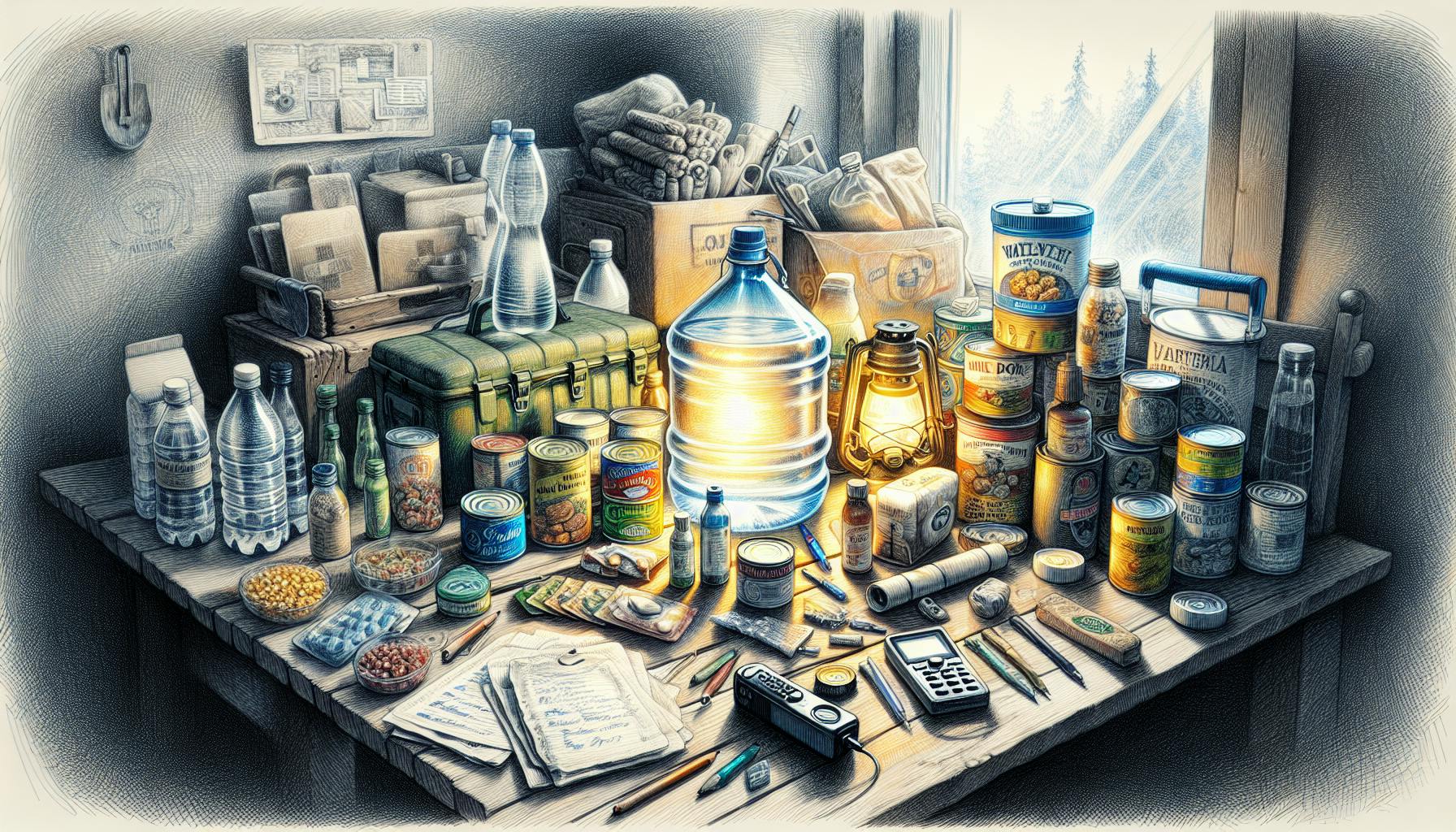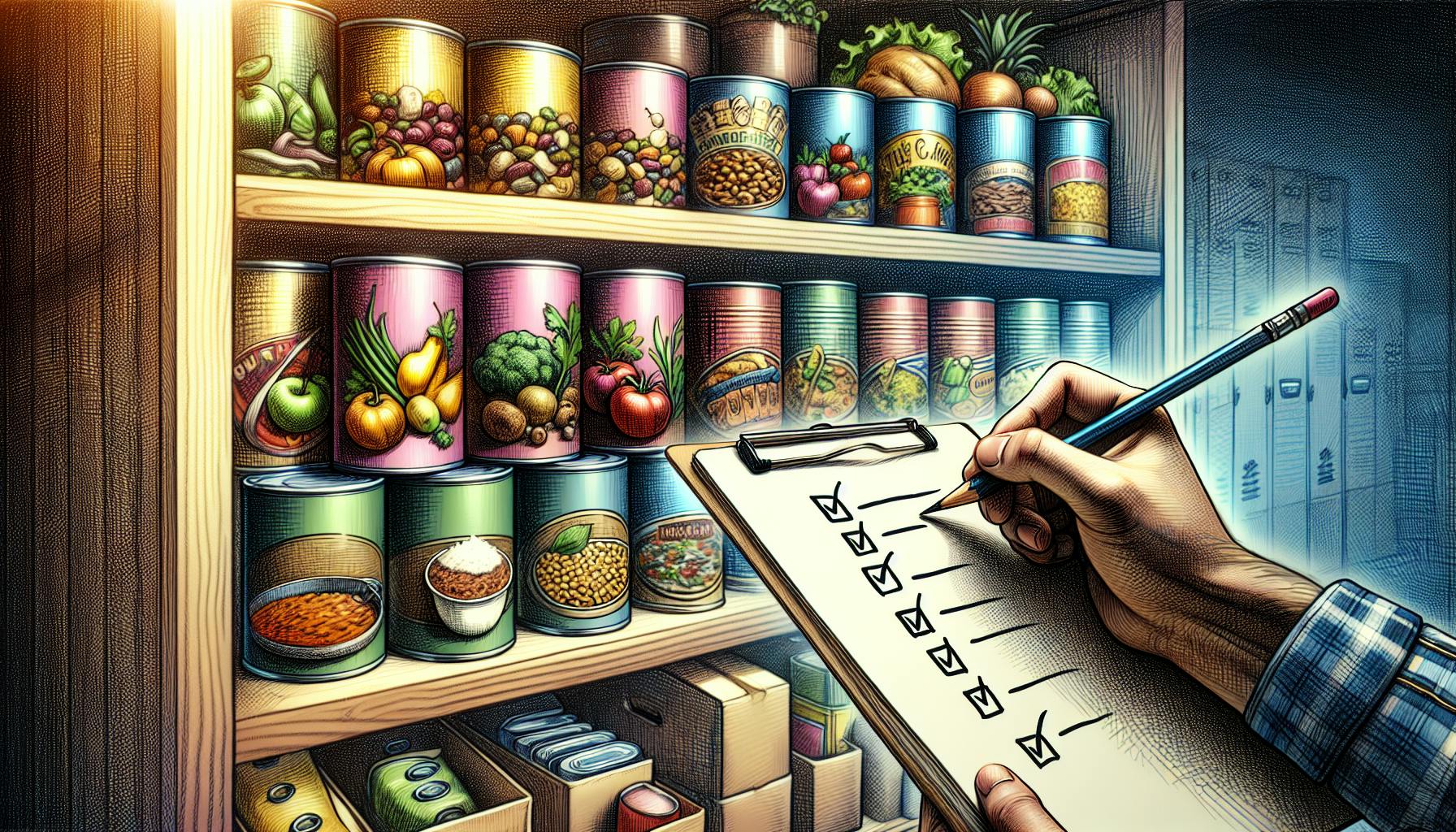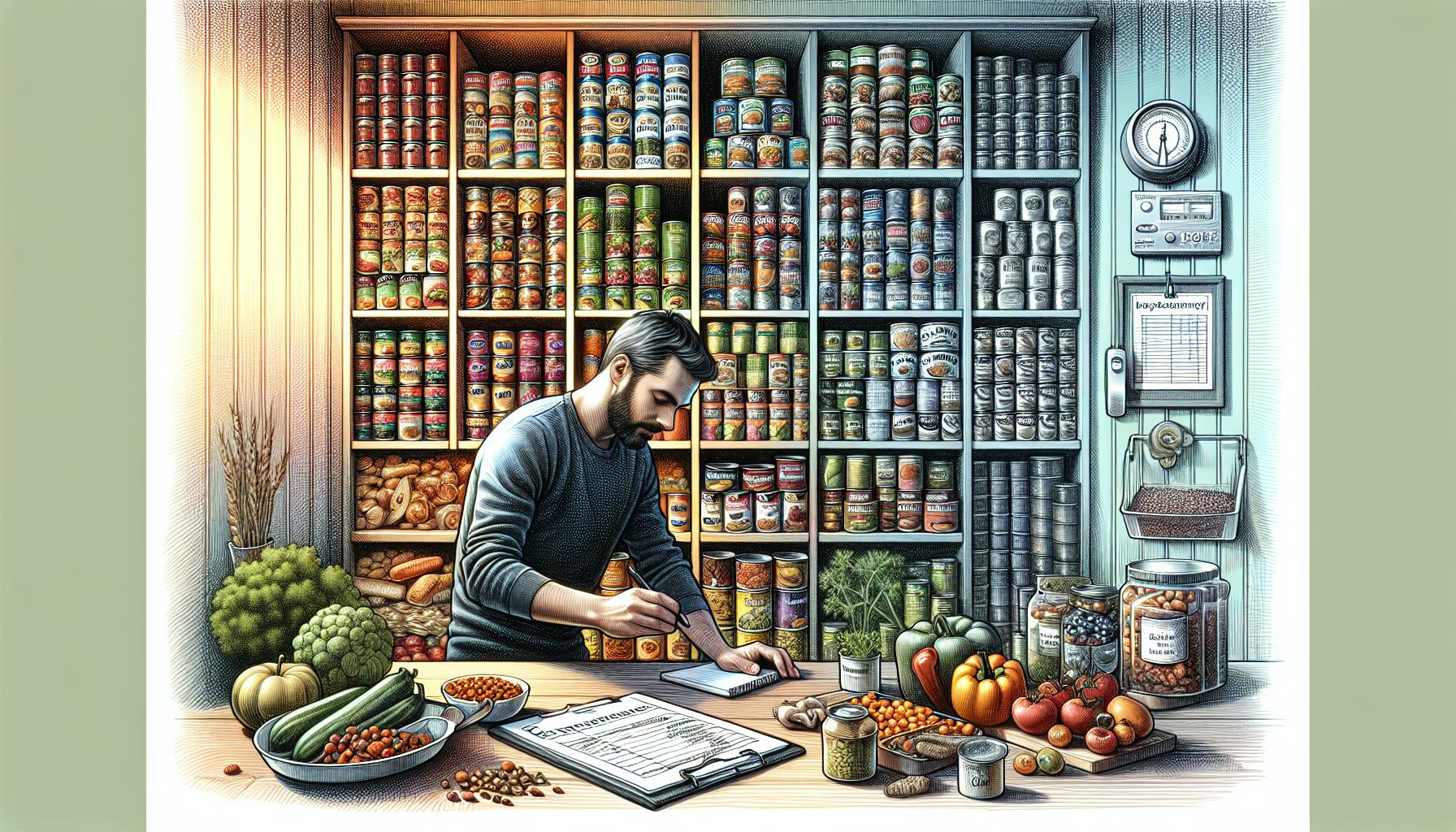When preparing for emergencies, we can all agree that having a reliable food supply is essential.
This guide will provide the must-have emergency food items to stock up on, focusing on longevity, nutritional value, and ease of preparation.
You'll discover the top-rated emergency food kits to buy, as well as how to assemble your own custom supply with canned goods, flour, and more. Tips are also included for maintaining freshness and accessibility of your stockpile.
Introduction to Emergency Food Storage Essentials
Having a reliable supply of emergency food is a critical part of any preparedness plan. The key factors to consider when stocking up on emergency food essentials include:
Understanding the Importance of an Emergency Supply Kit
An emergency supply kit provides sustenance and nutrition when access to food is limited. Key reasons to have emergency food storage include:
- Disaster situations - Severe weather, power outages, etc. can disrupt food supply chains. Stored food bridges gaps.
- Financial constraints - Lost wages from emergencies can limit grocery budgets. Stored food provides a buffer.
- Increased self-reliance - Not relying solely on external food sources bolsters resiliency.
When building your supply, tailor it to your household's unique needs and capabilities. Aim for a diverse mix of foods.
Selecting Foods That Last a Long Time
For emergency situations, shelf-stable foods with long shelf lives are essential. Ideal options include:
- Canned goods - Properly stored canned foods can last 2-5 years. Choose fruits, vegetables, beans, meat, fish, etc.
- Dried goods - Rice, pasta, oats, flour, etc. can last up to 30 years if stored properly.
- Freeze-dried meals - Pre-made entrees like Mountain House have a shelf life of 25+ years.
Check expiration dates and store foods properly to maximize freshness.
Ensuring Nutritional Value in Emergency Foods
In a crisis, nutrition is crucial but can be overlooked. When stocking up, consider:
- Balanced nutrition - Choose foods that provide carbs, protein, healthy fats, vitamins.
- Special needs - Tailor foods to medical conditions, diets, medications, infant needs.
- Supplements - Add vitamins, electrolyte mixes to fill nutritional gaps if needed.
Having nourishing foods avoids malnutrition and maintains health.
Focusing on Ease of Preparation
In an emergency, access to stoves, fuel, electricity for cooking may be limited. Consider:
- No-cook options - Canned goods, snack bars, dehydrated fruits, jerky.
- Just-add-water - Freeze dried meals, oatmeal packets, dehydrated camping meals.
- Simple heating - Canned foods that can be eaten cold or quickly heated.
Having easy, quick meal options saves time and conserves limited resources.
Creating and Storing an Emergency Water Supply
Storing water is as critical as storing food. Steps include:
- Store water - Have at least 1 gallon per person per day for drinking and sanitation.
- Water filters - Portable filters like LifeStraws make found water potable.
- Water pouches - Fill pouches like Reliance Aqua-Tainers with tap water for years of shelf life.
Having an ample water supply ensures health and proper food preparation during emergencies.
By focusing on shelf life, nutrition, and ease of preparation when stocking emergency food essentials, you can ensure your household will have healthy, convenient meals to rely on during any crisis situation.
What is the best foods to store for doomsday?
When preparing for an emergency, having a stockpile of non-perishable foods that provide nutritional value is essential. Some of the best options to include in your doomsday food storage are:
Peanut Butter
An excellent source of protein, peanut butter has a very long shelf life unopened. Opt for natural peanut butter rather than hydrogenated oils.
Whole-Wheat Crackers
Crackers made from whole grains have more nutrients and fiber compared to refined crackers. Pair with peanut butter for protein. Look for low or no sodium options.
Nuts and Trail Mixes
High in protein and healthy fats, various nuts and seeds last for months when stored properly. Tailor trail mixes to your nutritional needs.
Cereal
Choose whole grain cereals and granolas and store in airtight containers. Pair with shelf-stable milk or powdered milk.
Granola Bars and Protein Bars
Convenient for grabbing and going, stock up on bars with nutrients like protein, fiber and healthy fats. Check labels for excessive sugars.
Dried Fruits
Dried fruits like apricots and raisins retain nutrients and last a very long time when stored in a cool, dark place. No refrigeration required.
Canned Meats
Canned tuna, salmon, chicken and turkey provide essential proteins. Opt for low-sodium and canned in water.
Canned Vegetables
Canned veggies like green beans, carrots and peas are handy when fresh isn't possible. Rinse before use to reduce sodium content.
When building your emergency food supply, focus on nutrient-dense, non-perishable foods that align with your nutritional needs. Prioritize calories, macros, shelf-life and ease of preparation.
What is the best food for long term survival?
When it comes to stocking up on food for emergency preparedness, having items with a long shelf life is crucial. Some of the best options for long term survival include:
Soft Grains
- Oats, rye, quinoa - stable for about 8 years on average, up to 20 years in ideal storage conditions
Hard Grains
- Buckwheat, corn, flax, millet, wheat - can last from 12 years up to 30 years or longer
Canned Goods
- Canned meats, fruits, vegetables - safe to eat for 2-5 years when properly stored
Freeze-Dried Foods
- Freeze-dried meats, vegetables, fruits - last for 25-30 years
Other Essentials
- Honey, salt, sugar, vegetable oils - typically safe well beyond 10 years
- Hard candies, powdered drink mixes - indefinite shelf life
The key is proper storage - cool, dark place in sealed containers. Check expiration dates and watch for signs of spoilage before eating. Rotating stock also helps. With the right foods and storage methods, you can build an emergency food supply to last decades.
What is the best emergency food to store?
When building an emergency food supply, it's important to focus on shelf-stable foods that provide nutritional value, have a long shelf life, and are easy to prepare if the power goes out. Here are some of the best options to consider:
Canned and Dried Goods
Canned fruits, vegetables, beans, meats, and seafood are great for emergency storage. Opt for low-sodium varieties when possible. Canned goods generally last 2-5 years unopened. Other good options include:
- Canned juices and broths/soups
- Shelf-stable milk and juice boxes
- Crackers, cereal, granola bars
- Peanut butter and jelly
- Dried fruits and vegetables
- Nuts and trail mixes
Freeze-Dried and Dehydrated Foods
Freeze-dried foods like Mountain House and Wise Foods are lightweight and have a shelf life of 25+ years. They just require hot water for preparation. Dehydrated options like fruits, vegetables, and jerky are also great for emergency food storage.
MREs and Survival Food Kits
Meals Ready-to-Eat (MREs) contain full meals in lightweight packaging. They last for 5+ years when stored properly. Survival food kits from Augason Farms, Good To-Go, and others provide easy grab-and-go options.
The key is stocking up on a variety of foods that will provide balanced nutrition in an emergency situation. Prioritize longer shelf lives while also meeting dietary needs.
sbb-itb-b932644
What is the best food to stockpile?
When building an emergency food supply, it's important to stockpile nutritious and shelf-stable foods that don't require refrigeration. Some of the best options to include are:
-
Canned meats, beans, seafood: Canned proteins like tuna, salmon, chicken, turkey, and beans are nutritious, long-lasting, and easy to store. Choose low-sodium varieties when possible.
-
Canned fruits and vegetables: Fruits and veggies like peaches, pears, green beans, carrots, and tomatoes canned in juice provide essential vitamins. Rotate stock to use items before expiration.
-
Milk and cereal: Boxed, canned, or powdered milk offers calcium when fresh milk is unavailable. Pair with whole grain cereals or granola for a balanced meal.
-
Crackers, pretzels, nuts: High-carb snacks provide quick energy and satisfy cravings. Check best-by dates and store in airtight containers.
-
Water: Stockpile bottled water and containers for storing tap water. Plan for at least 1 gallon per person daily. Consider adding water filtration methods too.
Focus on nutrient-dense, non-perishable items that align with your family's tastes. Check expiration dates, store in cool, dark spaces, and rotate stock to maximize freshness and avoid waste.
Top-Rated Emergency Food Supply Kits
All-in-one kits offer an easy way to build your emergency food supply. Here are top-rated options for households big and small.
ReadyWise Emergency Food Supply: A Comprehensive Review
The ReadyWise Emergency Food Supply provides a comprehensive emergency food solution with a 25-year shelf life. It contains freeze-dried entrees, fruits, vegetables, proteins, and grains that can be prepared with hot water in 10-15 minutes. With 96 total servings, it can feed a family of 4 for over 2 weeks.
Customers praise the great taste and variety of meals, which include fan favorites like cheesy broccoli rice, chicken teriyaki with rice, and apple cinnamon oatmeal. The pouches make storage compact and portable in an emergency situation. One downside is the higher sodium content, so low-sodium dieters may need to balance with other items. Overall, the ReadyWise Emergency Food Supply is a high-quality and convenient emergency food kit.
Mountain House Essential Bucket: Why It's a Favorite
The Mountain House Essential Bucket provides over 20,000 calories with a shelf life up to 30 years for emergency preparedness. The compact 6-gallon bucket contains freeze-dried breakfasts, entrees, vegetables, and desserts that can be prepared in 12-15 minutes just by adding hot water.
This kit is a favorite for its reliability, nutrition, and great taste. Meals feature homestyle favorites like beef stroganoff, chicken teriyaki, scrambled eggs with bacon, and more. It's also praised for variety - containing more unique items like granola with blueberries and milk for breakfast. With over 15 different meals and sides, the Mountain House Essential Bucket delivers solid value at a reasonable price point.
Augason Farms Emergency Supply Food Kit: A Month's Worth of Meals
The Augason Farms Emergency Food Supply can sustain a family of 4 for up to a month with over 40,000 calories and 98 servings. It contains breakfasts, lunches, dinners, drinks, and snacks with a shelf life of up to 25 years. Meals are easy to prepare by adding water and can be made in around 10-15 minutes.
This kit provides excellent variety with meals like cheesy broccoli soup, creamy potato soup, vegetable stew, and chicken fried rice. There are also lots of kid-friendly options like mac and cheese and pancakes with syrup. An advantage of this kit is that it allows you to build customized meals. A downside is that some have found the taste slightly bland. But overall, the Augason Farms Emergency Food Supply delivers reliable nutrition and calories.
Survival Kit Supplies: The Wise Company 60-Serving Option
The Wise Company 60 Serving Preparedness Pack provides survival kit supplies for short-term emergencies. With 60 total servings, it can feed one person for two weeks or a family for several days. The bucket contains freeze-dried breakfasts, lunches, dinners, and drinks featuring meals like tomato basil soup, creamy potato soup, rice pilaf, and more.
This kit gets high marks for convenience with its compact size, lightweight portability, and 10-year shelf life. The meals only require hot water for preparation in around 15 minutes. One trade-off is that there are fewer unique offerings compared to larger Wise Company kits. But for a basic short-term food supply, it's a quality and affordable option.
Good To-Go Emergency Food Kit: For the Minimalist Prepper
The Good To-Go Emergency Food Kit provides an ultra-compact food supply for minimalist preppers. The kit contains 18 total servings of lightweight dehydrated meals that only require boiling water for preparation in about 10-15 minutes. The meals feature gourmet flavors like Thai curry, herbed mushroom risotto, and southwest chicken & rice.
This kit is designed for portability and ease of storage with its space-saving pouches. It's meant for short-term emergencies rather than long-term disaster preparedness. While tasty, the meals are lower in calories and textures may be more mushy. But for a highly portable emergency food supply, Good To-Go is a tasty choice.
Assembling Your Custom Emergency Food Storage
You can create your own well-rounded emergency food supply by stocking up on key staples and ingredients. Having a diverse range of foods that provide essential nutrients without requiring refrigeration is key.
Canned Varieties: Essential Nutrients Without Refrigeration
Canned proteins like tuna, salmon, chicken, and beans are nutritious, long-lasting additions to your emergency food supply. Canned fruits and vegetables are also great options that don't require refrigeration while providing vitamins and minerals. When shopping, check expiration dates and look for low-sodium varieties.
The Role of Properly Stored Flour in Emergency Food Storage
Flour can last 10-15 years when properly stored in airtight containers in cool, dark places. Whole wheat and white flour both have lengthy shelf lives. Consider storing flour for baking nutritious baked goods. Yeasted breads may be difficult without refrigeration, but flatbreads, muffins, and pancakes are great flour-based meals.
Backstock of Single Ingredients for Diverse Meal Options
Keep a diverse backstock of single ingredients like rice, beans, pasta, oats, quinoa, nuts, oils, and spices. Having a variety of ingredients allows you to create different meals like rice pilafs, pasta bakes, oatmeal, trail mixes, and more. It prevents food fatigue from repetitive meals during an emergency.
Low-Sodium Options for Health-Conscious Storage
Packaged and canned foods often have high sodium content. Be sure to stock low-sodium varieties as part of a balanced diet. Canned beans, tomatoes, tuna, salmon, chicken, and vegetables often come in low-sodium options. Pair them with homemade staples like rice, oats, pasta, and quinoa to control sodium intake.
Keeping Foods Fresh and Safe During a Power Outage
During power outages, perishables can spoil quickly. Have coolers and ice packs ready to preserve refrigerated items short-term. Eat them first before tapping into non-perishable emergency supplies. Cooked rice, pasta, and baked goods also need proper storage like airtight containers to prevent mold or spoilage. Monitor food temperatures and err on the side of caution.
Essential Tips for Maintaining Your Emergency Food Supply
Maintaining a well-stocked emergency food supply is critical for disaster preparedness. However, proper storage and organization is key to ensuring your food stays fresh and nutritious when you need it most. Here are some best practices for keeping your emergency rations intact.
Regularly Check Expiration Dates to Maintain Freshness
- Set reminders to check expiration dates every 3-6 months
- Write dates on containers with permanent marker
- Create an inventory list to track dates
- Set up area for food about to expire to be used first
- Replace expired items immediately
Keeping on top of expiration dates will ensure no food goes bad before you get the chance to use it.
Best Practices for Organizing and Accessing Your Supply
- Categorize foods (fruits, vegetables, grains, protein, etc.)
- Alphabetize cans, boxes, and pouches
- Label shelves and storage bins
- Keep inventory list updated
- Place items with sooner expiration dates in front
Proper organization will make your emergency food easy to access, use, and take stock of when disaster strikes.
Alternative Cooking Methods: The Utility of a Camp Stove
- Operates off small propane canisters
- Boils water quickly for hydration
- Heats canned foods, dehydrated meals
- Provides cooking option during power outage
- Small, portable, and easy to store
Having a reliable camp stove and fuel source is vital for cooking without power or gas.
The Importance of Drinking Enough Water Every Day
- Store at least 1 gallon per person for 3 days
- Use water purification tablets
- Have water filters like Lifestraws on hand
- Rotate supply every 6 months
Water is even more vital than food. Ensure ample drinking water storage and purification abilities.
Protecting Your Food Supply from Environmental Threats
- Store in cool, dark location if possible
- Use airtight plastic bins or storage containers
- Inspect regularly for signs of pests
- Consider adding oxygen absorbers to containers
- Keep off ground to avoid moisture damage
Take preventative measures to protect emergency food from elements like heat, light, insects and humidity.
Conclusion: Securing Your Nutritional Safety Net
Recap of Emergency Food Storage Must-Haves
When building your emergency food supply, be sure to focus on items with:
-
Long shelf lives: Look for non-perishable foods that can be stored for years if properly sealed, such as canned goods, freeze-dried meals, rice, beans, pasta, and more. Check expiration dates and rotate stock.
-
Nutritional value: Include nutrient-dense foods like canned fruits and vegetables, canned meats and fish, peanut butter, nuts and trail mixes. Avoid heavily processed items lacking vitamins.
-
Preparation ease: Have foods that require minimal cooking like granola bars, jerky, and ready-to-eat canned items. Stock a camp stove, sterno, and manual can opener.
-
Safe storage: Keep foods in a cool, dark place in airtight containers. Consider oxygen absorbers. Take stock every 6 months and replace anything compromised.
Final Thoughts on Preparing for the Unexpected
By taking time now to plan and build up an emergency food supply, you can ensure your household will remain nourished in any crisis situation. The peace of mind alone makes the effort worthwhile. Follow storage best practices, set reminder to routinely take stock and rotate items, and continue expanding your reserve. With the essentials covered, you can face uncertainty with confidence knowing your family's nutritional safety net is secure.


